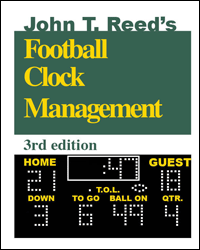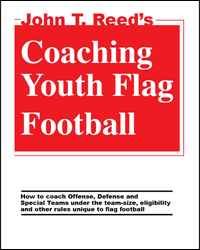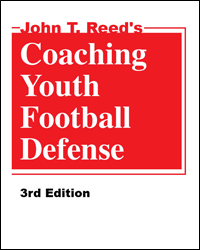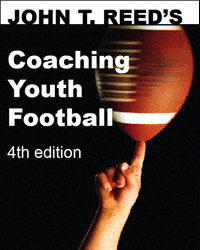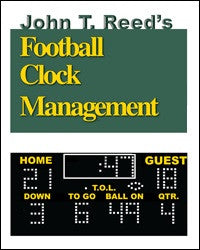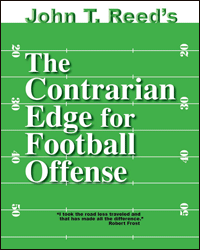
The Contrarian Edge for Football Offense, 2nd edition
My coaching books have longed urged readers to adopt contrarian approaches to offense. I wanted to write a whole book on how to do that and I finally have. It took me a year, but my latest coaching book—The Contrarian Edge For Football Offense—is now hot off the press. It was great fun to research and write.
All offenses must be unique
The basic idea is that all football offenses should be unique from the perspective of your opponents for the season. That is, you want your opponents who scout to have to revamp their whole defense for the one week they play you. (Your opponents who don’t scout will have to kiss their butts goodbye on game day.) You want your offense to bear as little resemblance as possible to the other offenses your opponents face during the season. That way you and your team get better and better at what you do week after week and season after season. But your opponents only get three to five days to figure how to stop it.
- 234 pages, 8 1/2 x 11 paperback, $29.95
- Reader comments
- Table of contents
- News and quotes about the Contrarian advantage in all fields
- Index
- Front matter (copyright page, etc.)
- Corrections and supplemental material
- Give your team the contrarian edge article
- ‘Mating calls’ of the contrarian coach’s opponents
- Turbo charge any offense with the warp-speed, no-huddle tempo
High-reps skills
It’s not just being different. It’s how you are different. For one thing, you want to be different in that you have multiple “high reps” skills. By “high reps” I mean that your team does things that take a long time to learn, like running the triple option or the buck lateral play or being excellent at faking.
You have a long time to learn them: in pre-season. But your opponents’ scout teams have to learn them in about 20 minutes on Monday or Tuesday so they can try to replicate them for their defense during the practices that week. The more reps it takes your players to learn the skill in question, the more impossible it will be for your opponent to replicate them on their offensive scout team and the less prepared your opponents will be to stop your offense.
Ju jitsu
Contrarianism also has a ju jitsu component. Ju jitsu is a Japanese martial art in which you use the opponent’s strengths and habits against him. Part of contrarianism as explained in my new book is to identify the strengths and habits of the best opposing defenses you will face this season. Then design your offense to turn the opponents’ strengths into weaknesses and their good habits into bad habits.
For example, most top defenses have linebackers who get an amazing jump on your plays. That is, they react extremely quickly to your formations and the first step of your players during a play. It is easy to design plays that take advantage of habits like that and make such reactions the wrong thing to do, make those fast reactions take the defender away from the play, not to it. During the game, they will look quite foolish at the beginning. Then, when they realize the keys they have always relied on are false keys when they play you, they will become tentative and quick-hitting plays will work better against them.
Tempo
Contrarian tempo can also give you the contrarian advantage. For example, run a tire-them-out, warp-speed no-huddle tempo that even snaps fast after a play that stops the clock like out of bounds or an incomplete pass. At the high school varsity and older levels, this will have your opponents’ first-string defenders throwing up on the sidelines and asking to be taken out of the game. At younger levels, it’s harder to tire them out, but easier to freak them out. They cannot run plays that fast. They will wonder how you can. Also, the warp-speed tempo is a high-reps skill that their offensive scout team will have great difficulty replicating.
Recruiting
Contrarianism is not just play design and tempo. It also relates to recruiting or NFL drafting and free-agent acquisition. Every fashionable or non-contrarian team is running roughly the same offense. That means they have to recruit or draft the same players.
If you are not winning the recruiting wars for those players, you’d better use a contrarian offense that optimizes the success of the players you can draft. If you did not finish last in last year’s NFL season, you’d better use a scheme that use the sorts of players you can acquire rather than asking second-tier players to impersonate first-round draft choices.
Your opponent’s assumptions
Assumption is the mother of all screw-ups. Analyze the video of your best opponent defenses to see what assumptions they made in the design of their defenses. Then design your offense so that their assumptions are wrong.
Ways you can be contrarian
You can be contrarian in all sorts of aspects of your team including:
- formations
- using ineligible receivers for more than just blocking
- legal but rarely seen snaps
- run-pass options
- throwing techniques like ambidextrousness, underhand or two-handed forward passes, and more
- ancient, forgotten or never-before-seen handoff techniques
- pass routes that break at different depths than normal and/or at different angles than normal
- using 11th man who is not “accounted for” by the defense on offense rather than having one—the quarterback—go off duty right after the play starts
- varying durations between ready-to-play signal, shifts, motions, and the snap unpredictably and differently than normal
- blocking with different positions than normally block the defender in question and coming from unexpected angles to make blocks
- turning the location of blocks and the path of the ball carrier into a maze rather than a straight alley
- the all-audible offense that always attacks the weak spot in the defense as seen by the offensive players on the field just before the snap not what the coach in the booth or the sideline thought was going to be the weak spot earlier
- using game theory and random numbers to make the opposing defense “watch everything” paranoid all the time
- the many times in the game when you need not fear complexity because you can show the players a complete diagram of the play just before the play
- the use of modular systems which allow you to generate thousands of different plays but only require each position to learn a small number of modules regarding what they do on the play
- contrarian run-pass balance like the 100%-run game plan that ended De La Salle High School’s 151-game win streak
- the contrarian principle of not picking the point of attack of a play until after the snap
- designing offensive two-point conversion plays in youth, high school, and the NFL where there is no chance of a defensive score on the play
- pouncing on liberalizing rules changes to incorporate new contrarian advantages into your offense as was done with the forward pass in the early twentieth century, allowing use of hands by offense in blocking, two-point conversions, platooning, coaching from the sideline, overtime rules, spiking the ball, intentional grounding from outside the box OK, and so forth
The Contrarian Edge for Football Offense also talks about the practical problems of installing and running contrarian approaches like parent and player resistance, criticism from outside pseudo coaches, being patient during the early learning phase, referee resistance, opposing coach resistance (always an excellent sign).
“Timeout! Timeout!”The book lists the “mating calls” of the contrarian coach opponents—things like:
- “Base! Base!”
- “When are you gonna stop running that damned __________ offense?! We have to waste a week of practice every year changing everything around just for that one game.”
- “It may be legal, but it’s not football!”
- “We’ll just ______________” (Coaches who overestimate how easy it will be to adjust to your contrarian schemes)
- “We’re not going to ruin a perfectly good defense just to get ready for one lousy game against a crazy coach.”
- “Everybody knows you always [or never] do such and such in football.”
- “Watch everything!”
Mandatory best practice
Contrarianism is not a philosophy or a suggestion or an idea you might want to try. It is a mandatory best practice, like making sure your players get lots of water during hot, humid weather. It is coaching malpractice to run a fashionable, same-as-everyone-else-to-avoid-criticism offense. Most coaches run the offense that their opponent defensive coordinators want them to run. What’s that about? If your opposing coaches are not complaining about the unusualness or craziness of your offense, you are not doing your job.
Contrarian offense is an irrefutably logical extension of the ancient principles of “Take what they give you” and the basic principle of offense: “Strength against weakness.”
It was all contrarian once
Everything football coaches now do was contrarian once upon a time. My new book tells the stories of many of the innovations that revolutionized and dominated the football world when they first were used by courageous and innovative coaches. You don’t even have to be innovative. Football has been around for so long that there are now many old, proven, but no longer used contrarian approaches that you can adopt.
The Contrarian Edge for Football Offense is designed to get you thinking about all the ways you can screw up your opponent and give your team clear advantages above and beyond your ability to “coach the off-tackle play better than your opponents” and your ability to recruit or draft better athletes.
Copyright by John T. Reed
234 pages 8 1/2 x 11 paperback
Surprisingly, Football Clock Management is contrarian. And the single wing is an offense that is a classic example of a proven football offense strategy becoming contrarian because it fell out of fashion.
When you buy 2 books at the same time, you save $2.55 on shipping to U.S. addresses. Shipping is free if you buy 3 or more books at the same time.
We Also Recommend

